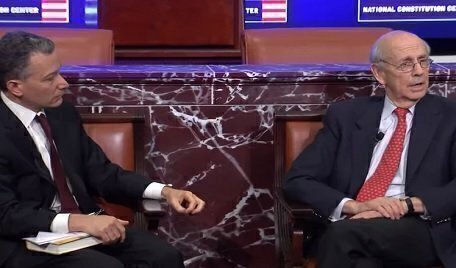Editor’s Note: Multiple media sources reported on January 26, 2022 that Justice Breyer intends to retire at the end of the current Supreme Court term. The story below was first published in July 2021.
If Justice Breyer, 83, were to step down from the court in the near future, his legacy will include an impressive list of majority and dissenting opinions.
 Breyer’s path to the Supreme Court included a mixture of academic, political, and judicial experiences. After graduating from Harvard Law School, Breyer taught law at Harvard, and he also worked as a counsel for the Senate Judiciary Committee. President Carter appointed Breyer in 1980 to the First Circuit Court of Appeals, where Breyer served as Chief Judge from 1990 until his Supreme Court confirmation in 1994.
Breyer’s path to the Supreme Court included a mixture of academic, political, and judicial experiences. After graduating from Harvard Law School, Breyer taught law at Harvard, and he also worked as a counsel for the Senate Judiciary Committee. President Carter appointed Breyer in 1980 to the First Circuit Court of Appeals, where Breyer served as Chief Judge from 1990 until his Supreme Court confirmation in 1994.
Breyer was the second of President Bill Clinton’s Supreme Court appointments, following Ruth Bader Ginsburg’s confirmation in August 1993. President Clinton nominated Breyer in May 1994, and he joined the court on August 3, 1994, almost a year after Justice Ginsburg.
Breyer had been a finalist for the appointment that eventually went to Justice Ginsburg in 1993. By May 1994, his name was usually mentioned at the top of the list to replace the retiring Harry Blackmun. The Senate confirmed Breyer by an 87 to 9 vote on July 29, 1994, and Breyer joined the Supreme Court in early August.
Breyer has gained a reputation since then as a careful and pragmatic jurist—often voting with the court’s more progressive justices. In a 2002 law review article, Breyer explained the role of pragmatic considerations in his approach to constitutional cases, “The real-world consequences of a particular interpretive decision, valued in terms of basic constitutional purposes, play an important role in constitutional decision making.” Breyer offered a broader account of his approach to the Constitution in his 2005 book, Active Liberty.
Among his noteworthy majority opinions were National Labor Relations Board v. Noel Canning (2014), where Breyer wrote for the court to clarify the president’s limited role in making recess appointments. In Stenberg v. Carhart (2000), Breyer wrote for a 5-4 majority that concluded that a Nebraska law that limited abortion was unconstitutional. In 2015, Breyer’s dissent in Glossip v. Gross asked the court to re-examine the constitutionality of the death penalty. Breyer believed the death penalty violated the Constitution’s Eighth Amendment, based on statistics compiled since the court upheld capital punishment in 1976. “For it is those changes, taken together with my own 20 years of experience on this Court, that lead me to believe that the death penalty, in and of itself, now likely constitutes a legally prohibited ‘cruel and unusual punishment,’” wrote Breyer in his dissent.
He also played a role in several important First Amendment decisions. In 2005, Breyer cast the deciding vote in a pair of cases with different majorities about the display of religious monuments in public spaces. In Van Orden v. Perry, Breyer’s concurring opinion sided with the majority in allowing a Ten Commandments monument to remain in place at the Texas State capitol. But in McCreary County v. American Civil Liberties Union (2005), Breyer voted with a majority that said two Ten Commandments exhibits at a Kentucky courthouse violated the First Amendment because they actively promoted religion. In his Van Orden concurrence, Breyer explained this difference between the cases in Texas and Kentucky. “This display [in Texas] has stood apparently uncontested for nearly two generations. That experience helps us understand that as a practical matter of degree this display is unlikely to prove divisive. And this matter of degree is, I believe, critical in a borderline case such as this one,” Breyer wrote. “This case . . . differs from McCreary County, where the short (and stormy) history of the courthouse Commandments’ displays demonstrates the substantially religious objectives of those who mounted them, and the effect of this readily apparent objective upon those who view them.”
Breyer also played a role in two major cases about the free speech rights of public school students. In Morse v. Frederick (2007), Breyer dissented from a decision that allowed a school to punish a student for displaying a banner that allegedly encouraged illegal drug use. Breyer concluded the case was more related to a question about qualified immunity for the school and not about the First Amendment.
Recently, Breyer wrote for a near unanimous court in Mahanoy Area School District v. B. L. (2021). In an 8-1 majority decision, the court concluded that a public school violated a cheerleader’s First Amendment’s free speech rights when she was suspended for cursing in an off-campus Snapchat session. Breyer’s opinion established several broad free speech guidelines but left room for future courts to decide other student free speech disputes. “It might be tempting to dismiss B. L.’s words as unworthy of the robust First Amendment protections discussed herein. But sometimes it is necessary to protect the superfluous in order to preserve the necessary,” Breyer concluded.
Finally, Breyer wrote the majority opinion in another important case in the current term, California v. Texas (2021). The 7-2 majority upheld the Affordable Care Act (or Obamacare) against a challenge that claimed the act was invalid after Congress eliminated its minimum essential coverage fine. Breyer and the majority justices disagreed, citing a lack of standing by the plaintiffs.
Scott Bomboy is the editor in chief of the National Constitution Center.







